I drove the 2024 Polestar 2 Long Range - the RWD Single Motor handles brilliantly and is best for range
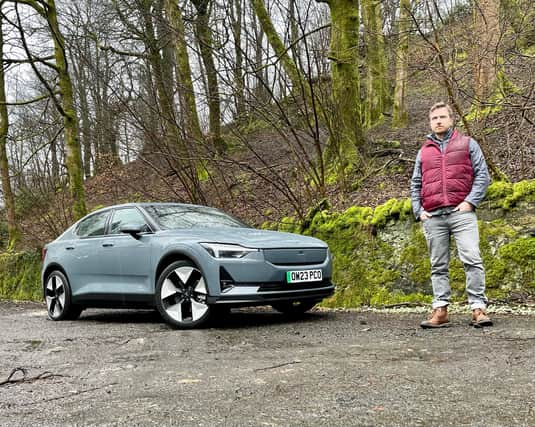

In the South West of Glasgow, at Silverburn Shopping Center, a Polestar electric car has spent the last 18-months parked next to a kiosk overlooked by a Starbucks and a Beaverbrooks. Pop-ups like this were the closest thing to an official sales hub for the Swedish car maker in Scotland. That all changed on March 21 after Polestar - a sub-brand of Volvo - cut the ribbon on the first permanent Polestar ‘Space’ in Scotland, a few yards away from the old pop-up site in a former retail unit.
After attending the ribbon-cutting ceremony, I took the opportunity to road test the Polestar 2, the brand’s stylish, recently-updated, five-door competitor to the likes of the Tesla Model 3, BMW i4 and Hyundai Ioniq 6. All clean lines and minimalist Scandinavian style, it’s as Swedish as Sandqvist bags and Stieg Larsson, but inside the cabin of my demonstrator was a little piece of Scotland, the premium upholstery wrapping the seats sourced from Renfrewshire-based Bridge of Weir Leather.
Advertisement
Hide AdAdvertisement
Hide AdSustainability is important to the brand positioning of a manufacturer like Polestar and the leather sourced from Bridge of Weir is fully traceable, chrome-free and animal welfare secured. Polestar has even made a feature of their upholstery’s provenance in their forthcoming SUV, the new Polestar 3, with the carbon footprint, animal welfare credibility and traceability of each seat printed prominently on each backrest.
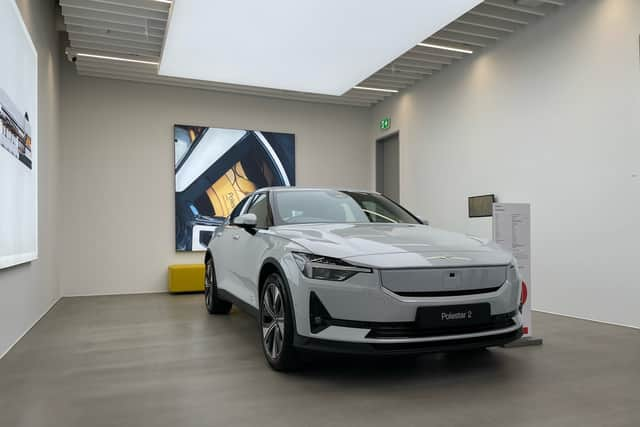

Driving the Polestar 2
As for the Polestar 2,Glasgow’s Southside and Renfrewshire provided the backdrop as I put our test car through its paces on the road. The ’24 model year has received a facelift, with the key change being a switch to rear-wheel drive as standard. Alas, the outgoing model is a gap in my resume, and not having driven it I can’t offer a comparison as to how the switch has altered the dynamics.
What I can say is that the Polestar 2, in refreshed form, is a fun to drive car. The steering successfully walks the tightrope of being easygoing in a relaxed drive and pin-sharp at speed. And that’s in the default setting, there are three steering modes to pick from if you’re of a mind to tinker. In the standard setting, there’s very little body roll at all, which is impressive for a car that tips the scales above 2,000kg in all but shortest-range guise. The ride is certainly firm, which is part of why it handles so well, but the trade off is quite a lot of feedback through bumpy speed-controlled stretches of road or potholed areas.
Those unfamiliar with one-pedal systems may take a few moments to get used to the regenerative braking system which, in ‘normal’ setting will bring you to a complete stop at lower speeds when you lift your feet off the accelerator pedal. You can turn it off completely through a relatively simple menu in the centre-mounted infotainment system, but it actually works really well and, at higher speeds, helps with the driving dynamics by effectively performing something approaching engine braking if you lift your foot during cornering. That’s not to mention the benefits to the range of channelling the energy generated through friction back into the battery.
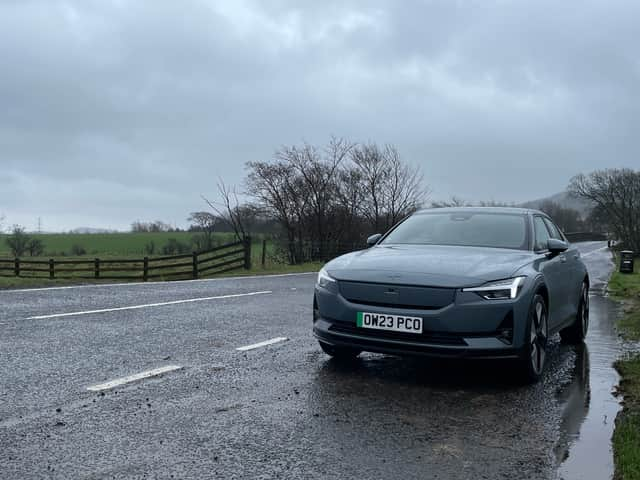

Speaking of range, the RWD, 82kWh model I tested can cover a distance of up to 406 miles from a single charge, whilst the standard range version has a range of 339 miles. Nought to 62mph for our single motor test car was 6.2 seconds, 0.2 seconds faster than the standard-range variant. The performance-minded driver has the option of the dual motor car with a 4.5-second nought to 62mph time. Adding the performance pack drops the sprint time to 4.2 seconds.
In both cases, the dual-motor variants sacrifice range for performance, leaving the long-range, single motor 2 the clear winner in terms of longevity between charges.
Interior, comfort and technology
In the cabin, the Polestar 2 is a lovely place to be. From the aforementioned premium nappa leather seats (a £4,000 optional upgrade from vegan textile upholstery), to the uncluttered but easy to use dash and the excellent road view to the front and side. In some ways, ‘uncluttered’ has been taken to an extreme and there’s not even an on/off button to start the ignition. Simply having your key in your pocket and sitting down is enough to power up the car and get it going. Getting out of the car and closing the door at your desired destination will, in turn, switch the car off. If that leaves you feeling antsy (it did for me), it’s possible to power the car down through the driving menu on the main screen, but if I’m being critical it feels like it’s a solution to a problem that didn’t exist in the first place.
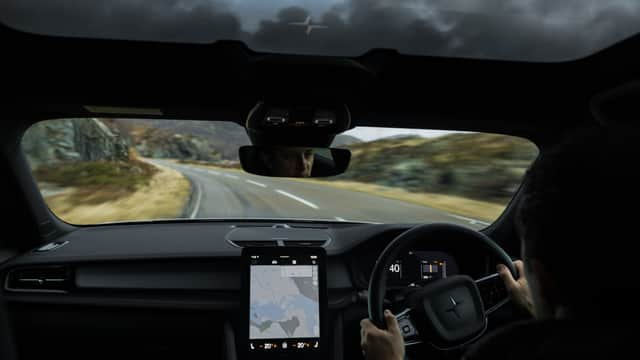

As good as the view is to the front and flank, the view through the rear window is pretty restrictive and, while the 360-degree camera parking system is clear and pops up with no lag when reverse is engaged, it suffers from the usual Scottish problem of road dirt and big beads of water on the lens making it look like a bit of a magic eye painting in heavy weather. A further annoyance was that the drive selector didn’t appear to give any auditory or visual feedback when shifting between neutral, drive and reverse.
Advertisement
Hide AdAdvertisement
Hide AdCar manufacturers are pretty good at designing cars, they have many, many years of practice after all. Where they often fall down is in designing operating systems. Which is why it’s a real positive that Polestar have forgone developing their own system in favour of basing their set up on Google OS. Navigation is via Google maps, Spotify is there as a default option for audio and you can download other music and streaming services via the Google Play store. Despite all this, Apple Carplay is still supported if you prefer the iPhone over the Android offering.
I’m a chief grumbler about the shoehorning of all basic functions into a labyrinth of touch-screen sub-menus but, it’s refreshingly simple to use on the move or stationary.
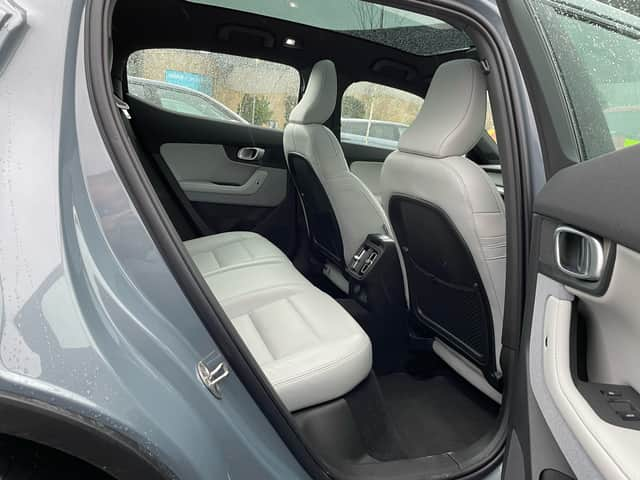

Interior space to the rear is reasonable, if not generous, and the Polestar 2 is a viable choice for families who, contrary to popular belief, don’t need to switch to an SUV just because they popped out a couple of kids. The 2 is a hatchback, lending it a degree of practicality and, while the boot isn’t huge thanks to the sloping roof, at 405 litres, 1,095 with the seats down, it should cover most use cases short of second-hand furniture. The hatchback configuration puts some deliberate space between the Polestar 2 and its obvious competitor, the Tesla Model 3, which is a saloon.
All Polestar 2 cars come with an 11kW on-board AC charger, which means eight hours to a full charge for the longer-range versions. DC charging for long-range cars is 205kW, which means an 80 per cent charge from a fast charging unit takes just 28 minutes. That increases slightly to 34 minutes on the standard-range car due to less capacity at 135kW.
Facts and figures
Price: From £48,950 (£61,850 as driven)
Motor: Permanent magnet, synchronous
Battery: 82kWh
Power: 220 kW (295 bhp)
Torque: 361 ft-lb
Transmission: Single-speed, rear-wheel drive
Top speed: 127mph;
0-62mph:6.2 seconds
WLTP range: Up to 406 miles
Consumption: 238.0-254.0 Wh/ mile
Charging: Up to 205kW
Verdict and pricing- should you buy the Polestar 2
The Polestar 2 is great to drive, fantastic to look at and even better to just sit in. While the dual motor, long-range version offers impressive performance headlines, the long-range single motor car feels more than quick enough and has the best range figure of the bunch, albeit at a £4,000 premium over the standard range car.
There’s a similar jump if you want the dual motor car, so if the 1.7 seconds gained to 62mph is important to you, you’ll be looking at £52,950 before options. That brings the dual motor car in dearer than the Tesla Model 3 Long Range Dual Motor, but undercuts the BMW i4.
At £48,950 RRP, the single motor, long-range car undercuts both. That makes this stylish, well-equipped, 400-plus mile range hatchback the pick of the litter.
Comments
Want to join the conversation? Please or to comment on this article.
